CURRENCY OF TRUST
Consumer Behaviors and Attitudes Toward Digital Financial Services in India



Omidyar Network is a philanthropic investment firm dedicated to harnessing the power of markets to create opportunity for people to improve their lives. Established in 2004 by eBay founder Pierre Omidyar and his wife Pam, the organization invests in and helps scale innovative organizations to catalyze economic and social change. Omidyar Network has committed more than $1 billion to for-profit companies and nonprofit organizations that foster economic advancement and encourage individual participation across multiple initiatives, including Education, Emerging Tech, Financial Inclusion, Governance & Citizen Engagement, and Property Rights. To learn more, visit www.omidyar.com, and follow on Twitter @omidyarnetwork #PositiveReturns.
Introduction 4
Ten Consumer Insights: Context for Digital Financial Services 6

Five Consumer Personas: Segmentation for Digital Financial Services 24
General Recommendations for Digital Financial Service Providers 36
Three Strategies for Stakeholder Action 40
Conclusion 42
Study Methodology 43
Acknowledgments and Endnotes 46
The emerging field of digital financial services is experiencing tremendous momentum in India. Efforts are being made across the board to pave the way for new technologies to fulfill their promise to empower consumers and change lives. Both private and public sectors are investing in building the infrastructure, products, and support frameworks needed to drive digital financial services penetration across the country’s complex marketplace. The entire ecosystem—including mobile network operators (MNOs), financial service providers, banks, regulators, and the government—is focused on a wide range of initiatives that will enable them to collectively bring mobilepowered financial services to the broadest spectrum of consumers.
India gives every indication of being “digitally ready,” with over a billion mobile subscribers, 72 percent mobile phone penetration, including over 250 million smartphones, and an increase in monthly data usage from 89 megabytes per subscriber in 2014 to 240 megabytes in 2016.1 However, at the same time, large segments of the population remain in digital darkness. Fewer than five out of 10 women own a mobile phone. 2 In rural areas, less than five percent of adults own a smartphone.3 Furthermore, 50 percent of smartphone owners across the country do not subscribe to data.4

Despite the digital diversity in India, there is great opportunity for digital financial service providers to reach consumers with numerous form factors and data access scenarios. However, adoption of this technology across consumer segments has been slow. It is clear that delivering new product offerings to the Indian market via the mobile phone won’t be successful without a deep understanding of the complexity of consumers’ needs, desires, and behaviors across such a varied segment base.
Indian consumer segments differ greatly in their aspirations and attitudes toward technology, as well as their access levels and usage patterns. People exhibit significant differences in their appetites for change and risk, underlying values and socio-cultural norms, and levels of education and financial literacy, along with an array of multi-dimensional needs. Digital financial services providers must also understand how to leverage existing frameworks, such as door-todoor agents and community savings groups, in order to drive sustained behavior change and foster trust.
For this reason, we commissioned a comprehensive research project in 2016 that focused on surfacing the voice of the Indian consumer regarding adoption and usage of digital financial services. In partnership with Dalberg Global Development Advisors, we conducted in-depth interviews with 384 people in 30 communities across the country, analyzed macro-level data sets and trends, and spoke with over 20 industry experts to develop a detailed understanding of the drivers for the adoption of digital financial services through a behavioral lens.
This report provides a synthesis of the “Currency of Trust” study findings. Ten key insights were gleaned from the many factors that shape the consumer context. Five personas helped to distill the most influential consumer desires and challenges around technology, essentially forming a segmentation model for digital financial services.
It is critical that every stakeholder listens to, and understands, the voice of the consumer when undertaking initiatives aimed at driving adoption of digital financial services. Consumers will guide how this platform unfolds across India, and the mobile ecosystem must respond accordingly in order to unlock its potential for consumers, commerce, and the economy at large.
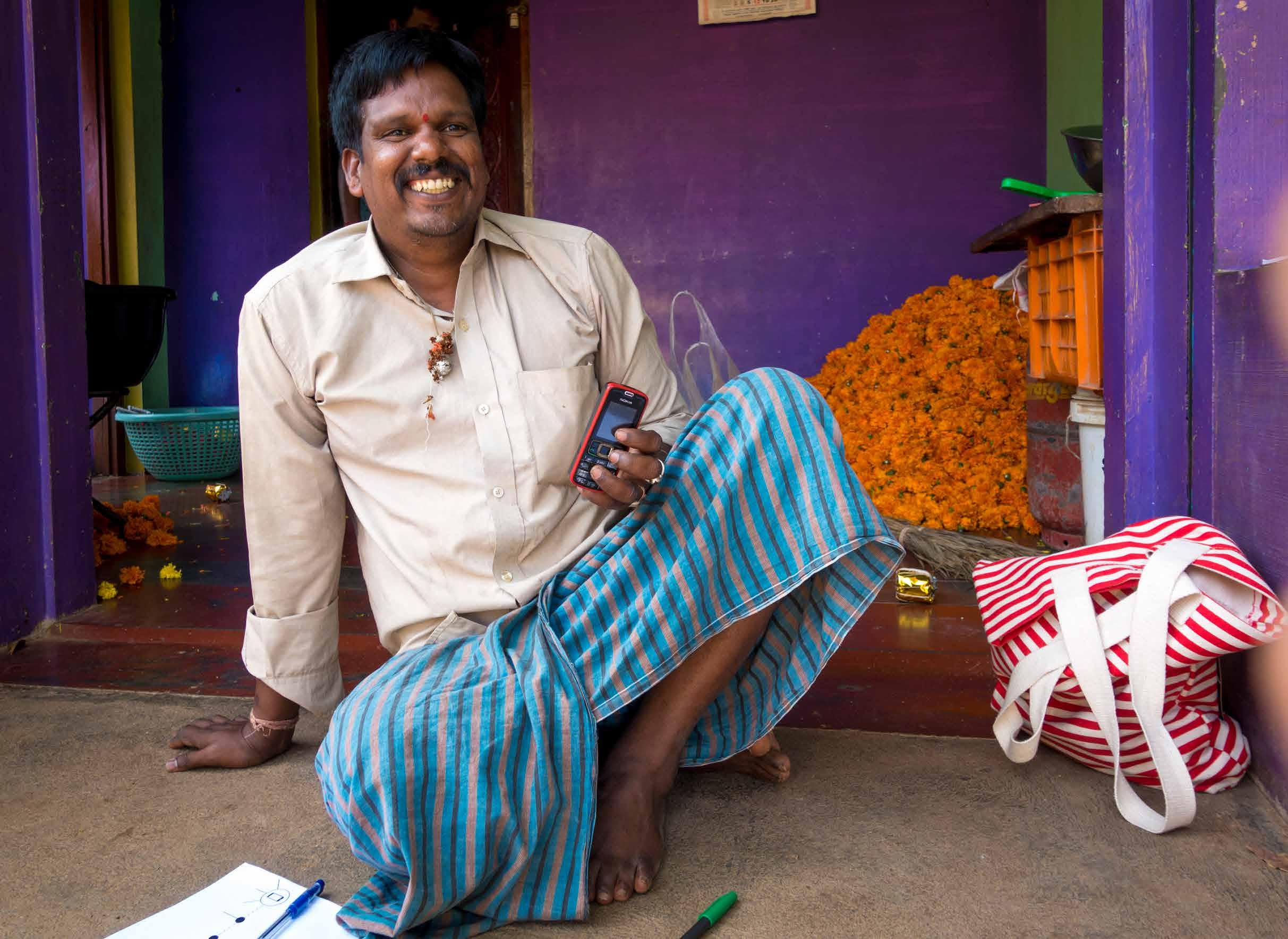
The spectrum of digital diversity in India is broad. Consumers across the country present a wide array of needs, attitudes, and behaviors with respect to mobile technology. Their choices are heavily influenced, not just by socioeconomic and demographic status and geography, but also by their context, motivations, and barriers faced. Our in-depth interviews and research surfaced a set of factors that impact the adoption of digital financial services across our sampling of consumers. These factors help to define the broader context facing financial services and technology providers in India. They include: access to mobile devices and data services, choice of devices and applications, gender roles and socio-cultural norms, existing financial services providers and preferences, digital literacy and self-confidence, data security, and consumer trust.
Based on our contextual findings, we have distilled 10 key insights that drive consumer behavior with respect to digital financial services. Consumer behavior in the digital ecosystem revolves around preferences for device and data and various notions of trust, proximity, simplicity, relevance, social collaboration, network effects, and gender needs. These insights will help innovators, service providers, regulators, and other key stakeholders better understand how to reach the potential market for digital financial services, as well as how to design products and services that address consumers’ real needs.
Smartphone aspiration is driving growth in market penetration. However, a sizable population will continue to be content with a basic feature phone.
People are highly frugal in their data use. They proactively seek out creative and cost-effective ways to access data.
The adoption of mobile apps is driven by data efficiency and social networks.
Greater access to digital finance for women requires developing a “safe space” that enables them to own and use mobile phones and data.
Digital financial services are viewed as overly complex.
Even financially savvy consumers are wary of accessing financial services on their phone and believe that formal financial services are not for them.
Some consumers may leapfrog directly to digital financial services based on convenience, relevance, and its alignment with socio-cultural norms.
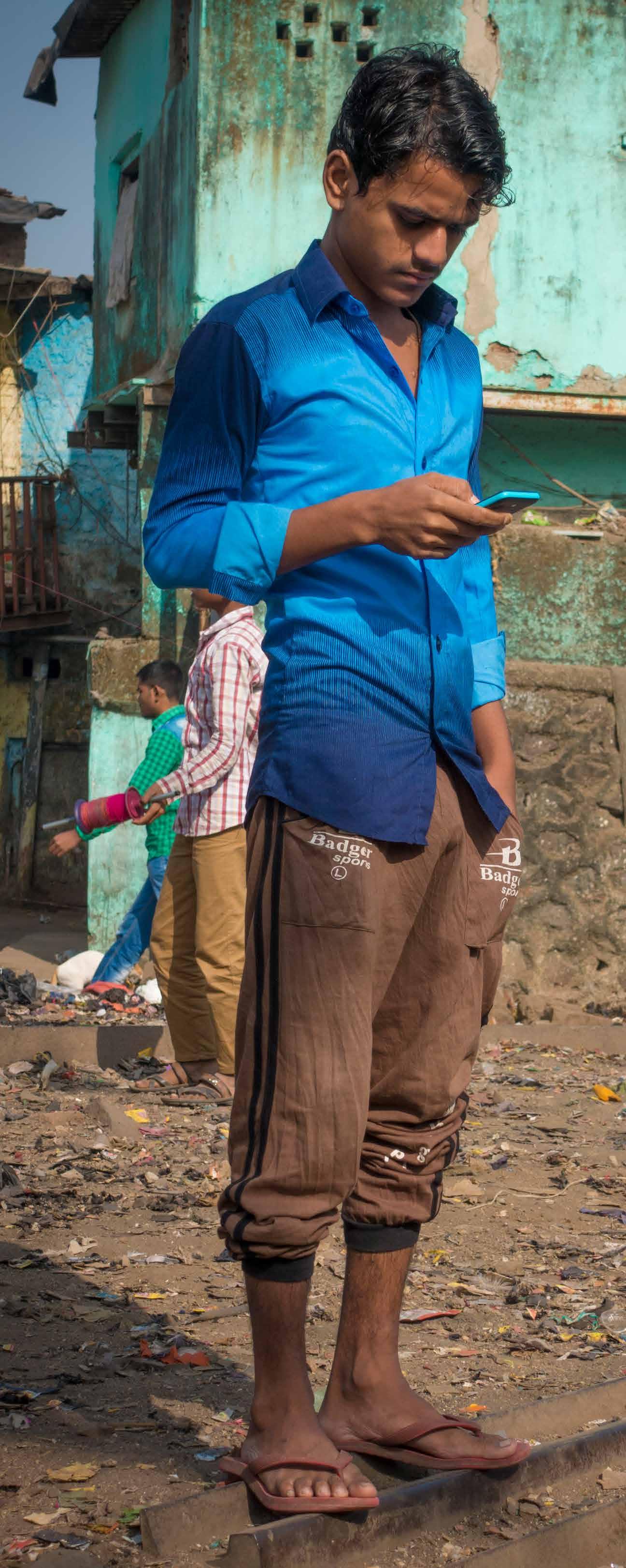
Security and fraud concerns around digital financial services must be clearly addressed.
Financial service agents, particularly those visible and active within the community, are critical to inspire trust.
Trust must be earned and sustained through continuous reinforcement throughout the consumer journey.
Mobile phone penetration in India is expected to rise from 65-75 percent in 2016 to 85-90 percent in 2020, at which time smartphone ownership will surpass basic feature phones and reach a projected 54 percent penetration nationwide. For many Indians, the ability to own a smartphone is considered a personal milestone and a source of pride. Smartphone owners are perceived as being part of a popular trend, although ownership in 2016 remained skewed toward those who live in large cities.
In the field, we interviewed many people who plan on spending a significant sum to buy a smartphone. For example, smartphone ownership aspiration motivates these consumers to consider giving up their first month’s salary, cashing in on their savings, using money earned as part of a scholarship, or even taking out a loan. Hardware quality is also important to people, with price being a determining factor of quality. We spoke with many consumers who consider phones costing between Rs. 8,000 and Rs. 10,000 to be the sweet spot in terms of value for money. Phones costing less are considered to have low-quality features, such as inferior cameras, poor battery life, and substandard performance.
Virhulu, weaver and farmer, Nagaland
While consumer interest and adoption of smartphones is growing, there remains a large percentage of consumers who are comfortable with their basic feature phones and do not plan to upgrade. This is primarily due to the greater resilience and longer battery life of lower-end phones, particularly in rural locations with poor connectivity and low-grade infrastructure. Moreover, these consumers do not see the appeal of smartphones and do not consider internet access a priority.
Previn, housekeeper earning Rs. 8,000 monthly, Mumbai, Maharashtra

“I purchased two smartphones worth Rs. 13,000 each online, one for myself and one for my daughter. I’m paying a monthly installment for the smartphones.”
1Smartphone aspiration is driving growth in market penetration. However, a sizable population will continue to be content with a basic feature phone.
“I am very comfortable with my Nokia keypad phone and don’t see any utility for a smartphone. Internet? I don’t use it.”
Despite the projected growth in smartphones over the next several years, by 2020 only half of smartphone owners in India are expected to subscribe to network data services on their device. Consumers tend to be savvy with respect to “data deals” and will seek out resourceful and cost-effective ways to access data services. Many people, particularly in metropolitan areas and large cities, access free WiFi connections through publicly available networks, such as the RailTEL and Google Wi-Fi services available in railway stations. They also seek out other free providers, such as their employers.
Mahesh, coconut factory employee, Jhallahundi, Karnataka
While interviewing study participants, we met some who had traveled to different cities to register for and receive a SIM card from Reliance Jio, which offers free access to 4G data for a limited time. We also observed groups of individuals, generally young males, sharing the installation, running costs, and passwords of broadband networks. In Mumbai’s lower-income neighborhoods, we found that households will share access to a Wi-Fi router instead of using 3G data. Other savvy users find creative ways for optimizing data cost and speed, such as switching between 2G and 3G networks based on their data needs at the time.
50 each and put up a local Wi-Fi router and use it. All of their friends know the password.”
BH Palkar, store owner, Dahivali village, Maharashtra

People are highly frugal in their data use. They proactively seek out creative and cost-effective ways to access data.
“In our village, groups of local youth pay Rs. 20 to Rs.
“I use 2G to download apps, since it is cheaper and the speed doesn’t matter for downloads. I switch to 3G when chatting.”
Chasu, vegetable trader, Zhavame village, Nagaland
When it comes to choosing which mobile applications to download and use, Indian consumers are influenced by two main factors: efficiency of data consumption and usage within social networks. As we have seen during numerous conversations, consumers are highly economical with their data usage and particularly sensitive with respect to data costs and access. It is therefore not surprising that they will favor apps that minimize data consumption. Moreover, people look for apps that provide an acceptable level of functionality and a satisfactory user experience, even in poor network conditions.

Consumer adoption is also influenced by the number of individuals within a person’s social network who are using the same application. We found that the uptake of specific apps within a community is usually due to the recommendations of a “master user.” This is typically a young, technologically savvy male, who regularly experiments with new applications. Master users are frequently approached within their social circle for information on new and trendy apps, onboarding, and troubleshooting.
Within our sampling, people demonstrated a clear brand association for specific use cases, such as UC browser—a mobile browser developed by the Chinese company UCWeb, which is owned by Alibaba Group of China—as a gateway to the internet (to browse content as well as access Facebook), SHAREit and Xender to transfer content and videos, and MX Player and YouTube to view content. WhatsApp was nearly pervasive across male smartphone users as it is known to work well even when connectivity is limited. Many people in both urban and rural areas make ad hoc use of WhatsApp for practical purposes. Examples of this pattern include: managing supply chains, providing proof of receipt of funds, and managing orders.
The adoption of mobile apps is driven by data efficiency and social networks.
“I take photos of tomatoes and cabbage and send them to a wholesaler on WhatsApp, who checks their quality and decides how many bags to buy. He then sends me a photo of a spreadsheet with a calculation of the amount owed. All on WhatsApp.”



















To the Indian consumer, smartphones are primarily associated with entertainment and social media—a perception that drives a significant gender divide in device ownership and data usage. There is an inherent fear that smartphones will expose women to “bad influences” and lead to sexual harassment or broken marriages. Many men refuse to provide their wives, daughters, or sisters with a smartphone—or in some cases any type of phone. Currently, only 44.1 percent of women own a mobile phone versus 73 percent of men, and women comprise only 35 percent of mobile internet users and 25 percent of Facebook users.
We spoke with some women who have internalized these perceptions and are self-restrictive in their desire for phones and use of the internet. We met many women who had smartphones, yet they were “dark users”—did not access the internet at all. Those who used data services specifically avoided WhatsApp and Facebook. They were worried about inadvertently accessing videos and images that were inappropriate for them. More importantly, many women said that using such apps would make their husband suspect that they may be talking to other men. Multiple men and women told us that newspaper articles and television news reported that social media usage by women leads to extramarital affairs and divorce.
Deepa, homemaker, Bengaluru, Karnataka
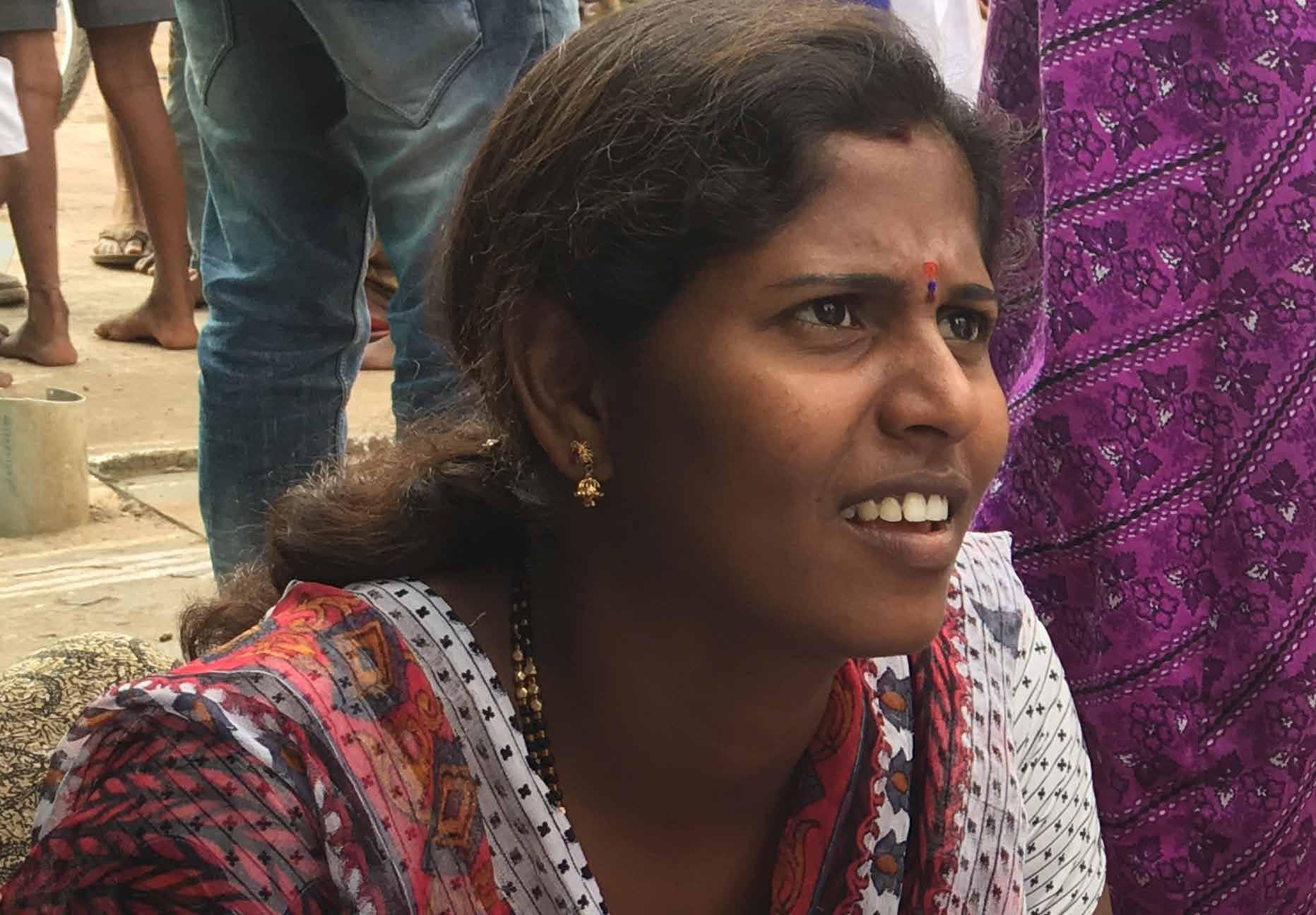
Greater access to digital finance for women requires developing a “safe space” that enables them to own and use mobile phones and data.
“As a woman, I should only use good things on the phone. So I don’t use WhatsApp or Facebook but just use my phone for calling. We saw on a TV show that internet leads to divorce and broken families.”
“Girls shouldn’t be given mobile phones. It is not appropriate. Who knows who they will talk to? I haven’t given a phone to my girl. She is in high school now, let her get married.”
Masterji, teacher, Masia Bigha village, Bihar
Digital financial services are viewed as overly complex.
Many consumers across India who have access to a smartphone and the mobile internet are quick to experiment with connected services on their device. They are willing to engage in a wide range of digital experiences, either for entertainment or practical purposes, such as: shopping, movie streaming, video playback, file sharing, information browsing, and social media communication.

However, in the course of this study, we did not observe such exploration with respect to digital financial services. Even the most advanced users do not seem to naturally transition to experimental or sustained usage. We spoke with many people who perceive digital financial services to be more complex than other types of connected services. They consider those users who can understand and navigate financial service apps as having a specialized skill. In addition, we found that many people have difficulty grasping related product offerings, financial services language, and legal terms and conditions.
Trust has always been the cornerstone of the banking and financial services industry. Juntos, one of Omidyar Network’s portfolio companies, is an automated mobile conversation platform that empowers newly-banked consumers to increase usage of their dormant financial services accounts. Much of their work in markets around the world centers on questions of confidence and trust with respect to digital financial services. Juntos breaks down the key issue of trust into a framework of three levels, which they call the “three economies of trust”:
1) Trust in the provider, which is well-understood and usually emphasized
2) Trust in the digital product or service and its ability to work as expected
3) Trust in oneself, which is normally least appreciated, but most important
Kaushik, street hawker, Hyderabad, Telengana
“WhatsApp and watching videos is one thing. Who wants to get into all this brain-bashing stuff of online transaction? We don’t want all the headache.”
Financial services providers spend most of their time and resources building provider trust through their brand. However, this is likely to be the least important focus area, especially if there is a lack of trust in the other two areas, product and self. Our research indicates that one of the biggest hurdles today for Indians with respect to digital financial services adoption is the lack of trust in their own abilities. Many first-time users neither trust themselves nor the product, and therefore experience a high degree of risk. It is important to lower the stakes for these users. Migrants in urban areas, despite being regular users of entertainment and communication applications, still use more traditional services for sending money home. They will opt for third-party remittance providers or informal means of remittance, as opposed to engaging in digital financial services directly through apps on their mobile device.

“Having a simple and guided few steps process with clear instructions for money transfer would be quite cool.”
Pavan, college student, Karjat town, Maharashtra
them.
Going beyond digital financial services, a significant population in India does not consider formal banking to be a viable option. Many villagers have multiple bank accounts due to various government schemes; however, this has not resulted in everyday use of these accounts or on-ramp to other formal financial services. Due to the complexity of their financial lives, they choose alternative financial services or informal means for saving and borrowing money, viewing these as more appropriate to meet their needs.

Mangai, homemaker, Chennipulamulli village, Karnataka
This belief stems from a combination of three factors: 1) a perception that banking is only for large ticket transactions; 2) a lack of ability to understand financial services due to heavy usage of jargon and content not found in the local colloquial language; and 3) apathy and outright disrespect experienced by many during interactions with formal financial service providers.
As a result, there is a strong preference for alternative services, such as self-help groups (SHGs), microfinance institutions (MFIs), chit funds, savings associations, loans against gold holdings, and private moneylenders. Informal approaches to saving and borrowing are also common. Multiple people told us: “Yes, I have a bank account, but when I need to borrow money, I do it from friends or relatives.” We came across many people like Manoj, a street hawker in Bihar, who had saved money in a “secret” compartment in his wallet for two years to buy his first smartphone. Though Manoj has two bank accounts, he rarely uses them.
special box at home labeled ‘sister’s wedding’.
bank account,
bank
Sone, street hawker, shuttles between Patna and Champaran village, Bihar
Even financially savvy consumers are wary of accessing financial services on their phone and believe that formal financial services are not for
“I save money in a
I have a
but who wants to go to the
to deal with the hotchpotch? We are illiterate and happy with our way.”
“The gold loan agent speaks politely and offers me water. He patiently explains the loan process. Also, I get the loan within a few minutes.”
Despite the low comfort level and lack of familiarity with digital financial services, many Indian consumers expressed a willingness to start using such apps under certain circumstances. If the technology addressed unmet needs, offered convenience, and did not challenge established socio-cultural norms, some consumers are likely to leapfrog formal financial services and go directly to digital financial services.
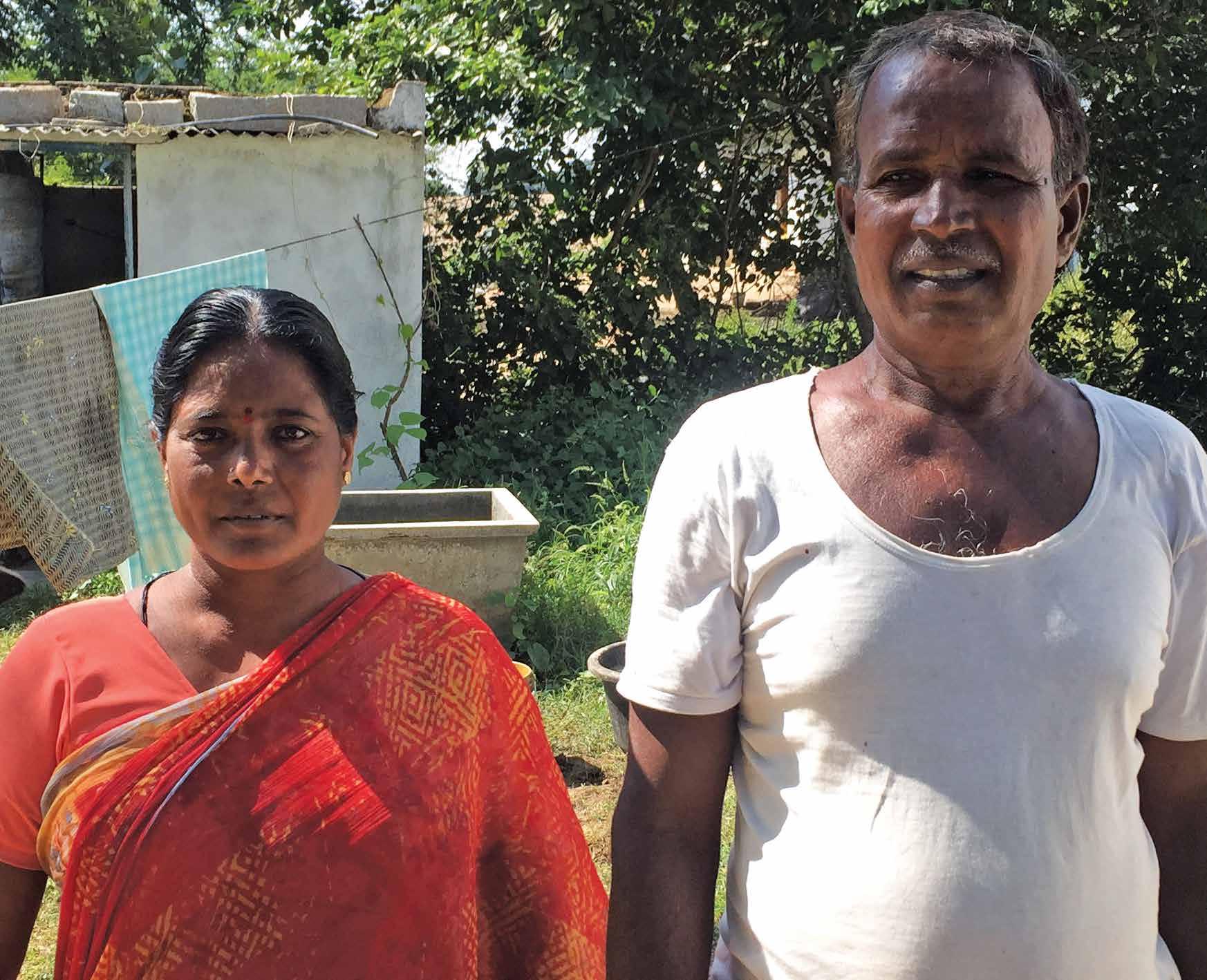
Consumers want financial solutions which offer value propositions that fit the existing context of their lives. Consumers make multiple decisions on a daily basis to manage their limited income to meet their needs. They seek solutions that provide them with greater control of their money by balancing their need for flow (availability of cash as needed) and illiquidity (simple barriers to prevent withdrawal of any savings for discretionary purposes).
To shift consumers from existing informal cash–based financial solutions to formal digital financial products, solutions need to capture the full relationship and experience of money in their lives. Most financial products are designed for a specific use. However, customers do not necessarily think in terms of products. Instead, what they seek are tools that address their latent needs. As the value proposition in terms of usability is low, we see high dormancy rates across financial products.
Simple design changes to the user interface of digital accounts, like allowing consumers to create partitions (virtual jars) for the money stored in the account, can resonate with their current practices and needs. They then become tools that can help small businesses manage cash flow or housewives manage household expenditures.
Some consumers may leapfrog directly to digital financial services based on convenience, relevance, and its alignment with socio-cultural norms.
“My wife handles all the subsidies and loan repayments. She gets messages on her mobile phone about that. I don’t mind if she manages all this on her phone.”
Govindraj, garland maker, Chennipulamulli village, Karnataka
A common reason cited for adopting digital financial services was an emergency or last minute expenditure and no cash in hand. For example, Sumesh, a stockbroker, told us that he had resisted using financial apps. However, one night he had to use an app to make a late payment in order to meet a billing deadline. He has continued using digital financial services ever since.
During many conversations, men expressed acceptance of their wives saving money, and potentially adopting digital means to manage the money—as long as the money was meant for their children’s future or household emergencies. This offers an emerging space for women to use digital financial services to manage family finances, including small credit portfolios and government subsidies.
Patel, homemaker, Mumbai, Maharashtra
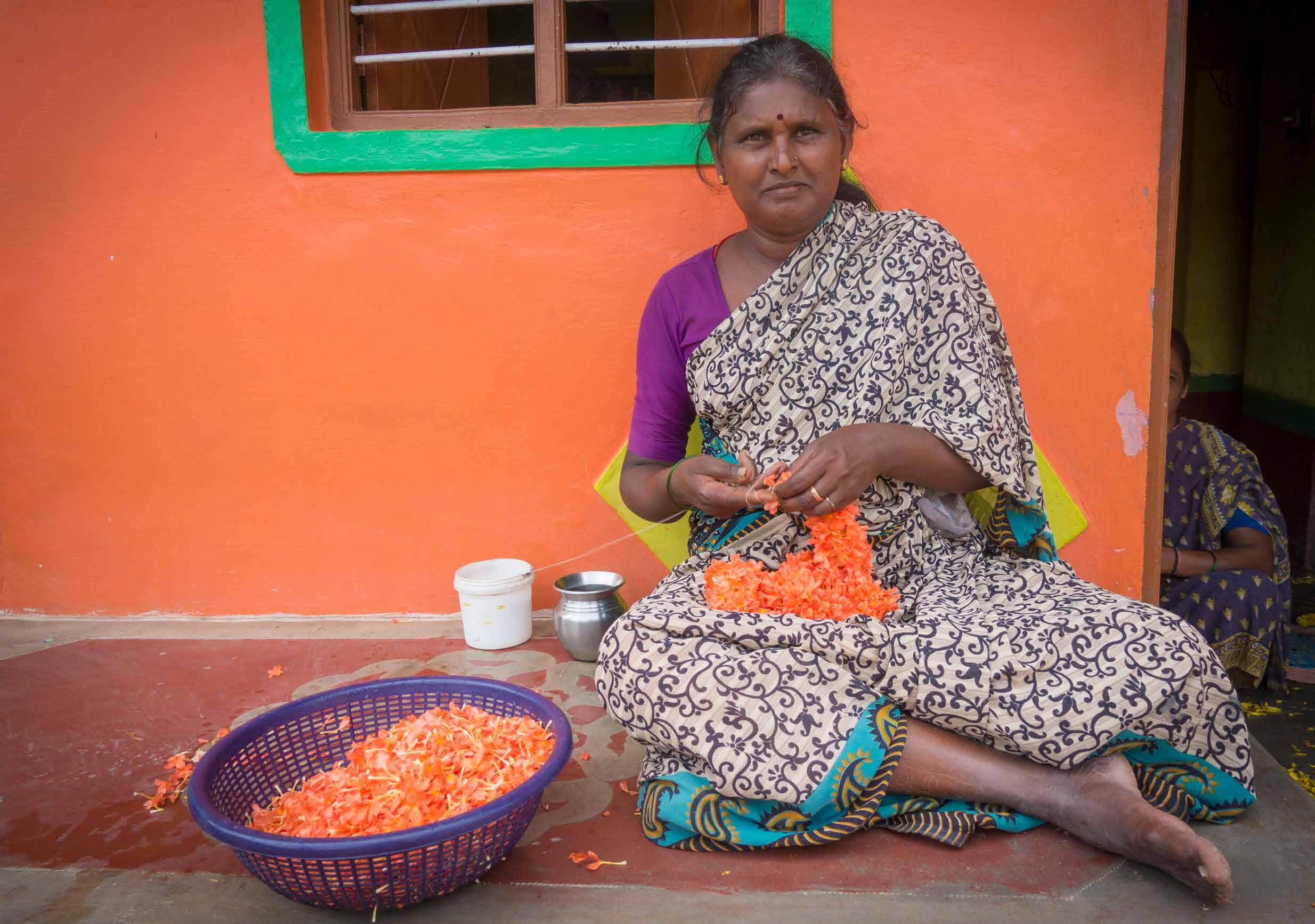
“Two days after demonetization, I took my 3-year-old daughter to the government hospital 45 minutes away to have her tested for tuberculosis. But they refused to accept my old notes, even though Modi said hospitals should accept them. If at that time someone had told me about digital financial services and taught me how to use them, I would have.”
Ayesha
Umesh, moneylender, Chennipulamulli village, Karnataka
Heightened awareness and concern about bankingrelated fraud in India has produced a general mistrust of digital financial services. Heavy media coverage, extensive hearsay, and precautionary communications from banks have amplified this mistrust as consumers hear stories about impersonations, ATM fraud, and other scams. When asked, many people admit that it has never happened to them, but they have either heard about it through a trusted source or seen it in the news. Rajat Sinha, chief manager of Allahabad Bank, Patna, expressed: “People nowadays have a perception that fraud happens, and hence don’t do mobile banking.”

We spoke with many people who had received repeated proactive messages from banks reminding them to change their ATM PIN number frequently, be wary of fraudulent calls, and look out for other scams. This increased emphasis on fraud coming from banks makes people doubt the safety of the banking system itself. They believe that banks are not in full control of the money entrusted to them, prompting consumers to consider other options. Another factor that emerged was consumer misunderstanding of banking terminology, such as the difference between a PIN and an account number. Many people we interviewed were also confused over which types of banking information can and cannot be shared. A garland maker told us that she did not allow her informal savings group to deposit money directly into her bank account because her bank had asked her not to give her account number to anyone. To be safe, many consumers prefer to manually deposit cash themselves rather than share their account numbers with others.
Looking at the application user experience, consumers widely appreciated two-step authentication measures, such as a one-time password (OTP), which help to build trust. However, many users told us that they would need assistance with the first few transactions, along with an auto-read feature for SMS and a user experience that allows them to toggle between SMS and the app without logging out of the session.
Sunil, Britannia distributor, Dahivali village, Maharashtra
Security and fraud concerns around digital financial services must be clearly addressed.
“Wow, I didn’t know that there is already a security system in which I can get an SMS on my mobile with a one-time password to use for authentication of online payment. But how do I copy it without exiting the app?”
“Most of us get SMS in English from banks. It would be great to get them in Kannada so that we can read them. I understand numbers and the days of the week in English, but all the rest has to be in Kannada.”
For customers, service proximity means touchpoints that are frequent and available when they need help, rather than simply the location or number of bank branches. Many consumers in India are comfortable interacting with in-person banking agents for their financial services needs due to the local agents’ proximity, familiarity, and respectful conduct. The number of agents across the country has been growing at approximately 50 percent yearon-year since 2013. However, this still leaves India lagging far behind many other developing countries (see next page).

Agents not only provide financial services on behalf of their customers, but they also assist with basic tasks, such as filling out deposit slips. Moreover, the trust established through such interpersonal relationships prompts many people to rely on agents for financial advice. Agents proactively reach out to customers in rural areas on a regular basis, keeping them informed of relevant schemes and products, reminding them of loan repayments, and encouraging them to save money. Such interactions make customers feel that the agents are looking out for their interests.
Shantama, homemaker, Magasapura village, Karnataka
With regards to digital financial services, many people will browse the internet on their mobile device to research financial products, yet they still want the initial transaction to be in person. However, once established, consumers expressed a strong interest in accessing and managing their financial products through a mobile application.
Financial service agents, particularly those visible and active within the community, are critical to inspire trust.
“The same loan agent has been coming to the village every week for about 20 years. He doesn’t cheat us and explains things to us. He asks if we need money. He calls to remind us of loan repayments. We have never had a problem.”

To drive adoption in the Indian market, digital financial service providers must lower barriers for people at every point along the consumer journey and pay particular attention to first-time users. Apps must be carefully designed to build trust and grow with the user as he/she becomes more confident and familiar with the experience and service. During our study, several key focus areas emerged with respect to consumer engagement.
Consumers express a strong preference for an onboarding process that: 1) explains the relevant use cases, 2) provides access to the service, 3) helps them complete registration, and 4) guides them through the first few transactions. Many users state that bank agents download mobile banking apps on their phones, but do not explain the functionality and use of the app. As a result, they delete the apps without using them.
An uncluttered user interface (UI) and easy-to-understand user experience (UX) can dramatically improve consumer adoption. Many app users are overwhelmed by a complex interface, especially during the first few transactions. They lack confidence when entering personal details (e.g., account or PIN number), fearing that it may result in fraud or lost money. Widely appreciated are UIs that feature “tap not type” input, communicate in a local colloquial language, include a heavy use of images, and are free of financial service jargon. Also important is a UX that focuses on one use case at a time, without multiple options that may confuse users.
“When I went to ICICI bank, they installed the mobile banking app in my mobile and taught me how to register and use it. Now I use it to recharge my phone and check my balance.”
Victor, store owner, Kohima, Nagaland
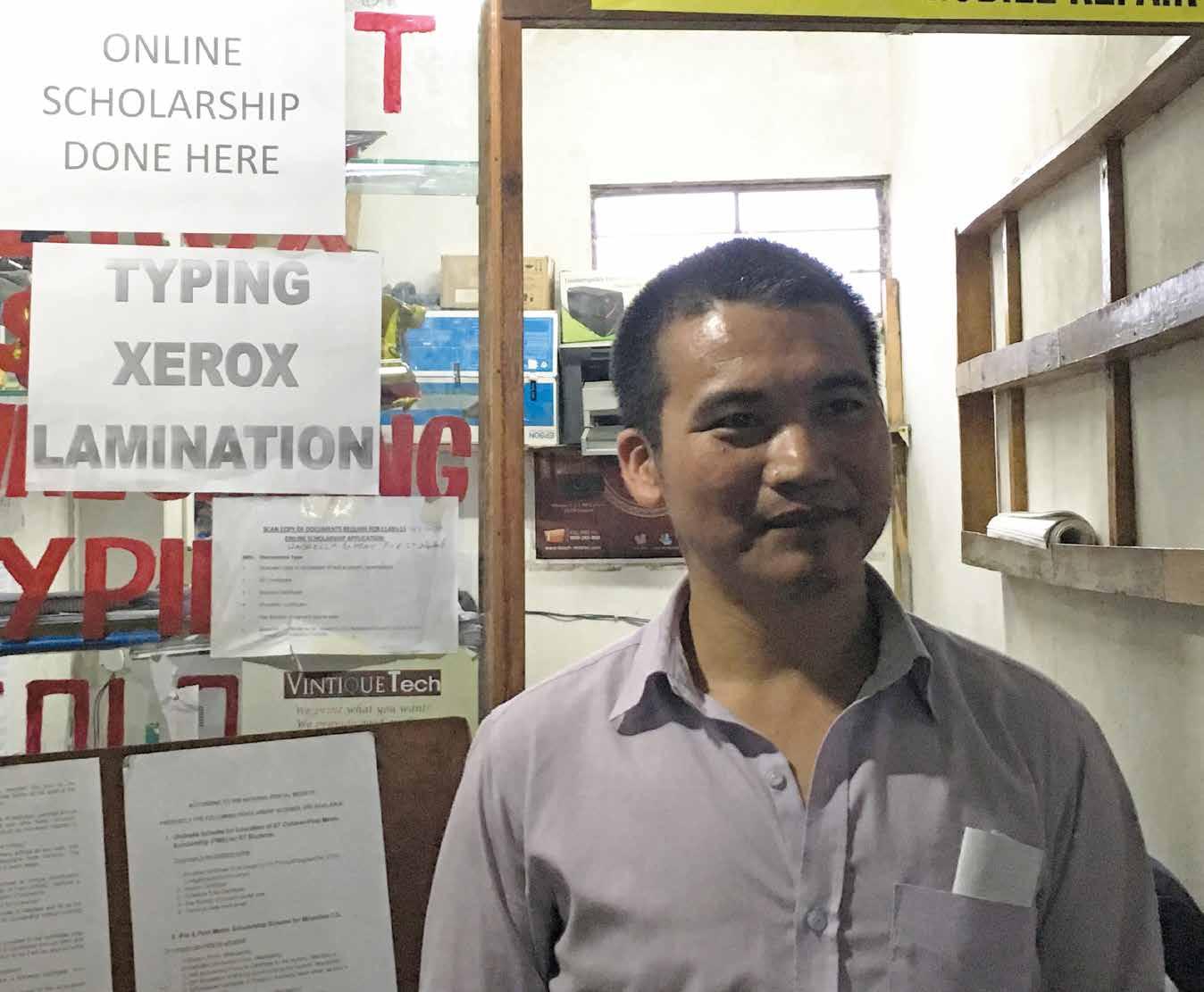
10 Trust must be earned and sustained through continuous reinforcement throughout the consumer journey.
We facilitated discussion using prompt/trigger/ provocation cards in order to understand if consumers were able to identify with the UI for potential use cases.
Semi-literate villagers and informal financial service providers (SHGs, private finance) were interested in graphically rich mobile apps that track household expenses and maintain digital customer credit records. They wanted imagebased user experiences that use graphics or pictures to represent key information.
We facilitated discussions using relationship charts and mobile phone stencils to understand the UI/UX requirements, specifically those related to the language of digital financial services.


Semi-literate villagers were excited about having instructions in their local language (Kannada) rather than in English. They also expressed a desire to receive communications via SMS on loan repayments, bank transactions, and subsidies in Kannada.
During early usage, consumers are more comfortable transacting with small amounts of money. As they build trust and become more familiar with the service, they are more open to transacting with progressively larger sums. Users fear that they may lose money due to their inexperience, and therefore tend to mistrust the service itself. Micro-transactions are perceived as a safer way of trying out a new service while keeping risk contained.
Across formal and alternative financial services, consumers value some form of proof for both successful and incomplete transactions. Similarly, with digital financial services, apps that send instant notifications after processing (e.g., via SMS) help reassure users and reinforce trust in the service. Users worry about what will happen to their money if a digital transaction fails during processing. In this case, providing evidence of a failed transaction is an important driver of a positive user experience.
When they get stuck, users want their app to know where they are in the process and provide specific, easy-tofollow assistance on demand. Such features also help consumers overcome a lack of confidence and perception that they may not be sufficiently educated to use digital financial services. We spoke with several people who expressed a desire for a clear path to grievance redressal on their mobile phone, stating that it could be used to tackle cheating by middlemen.
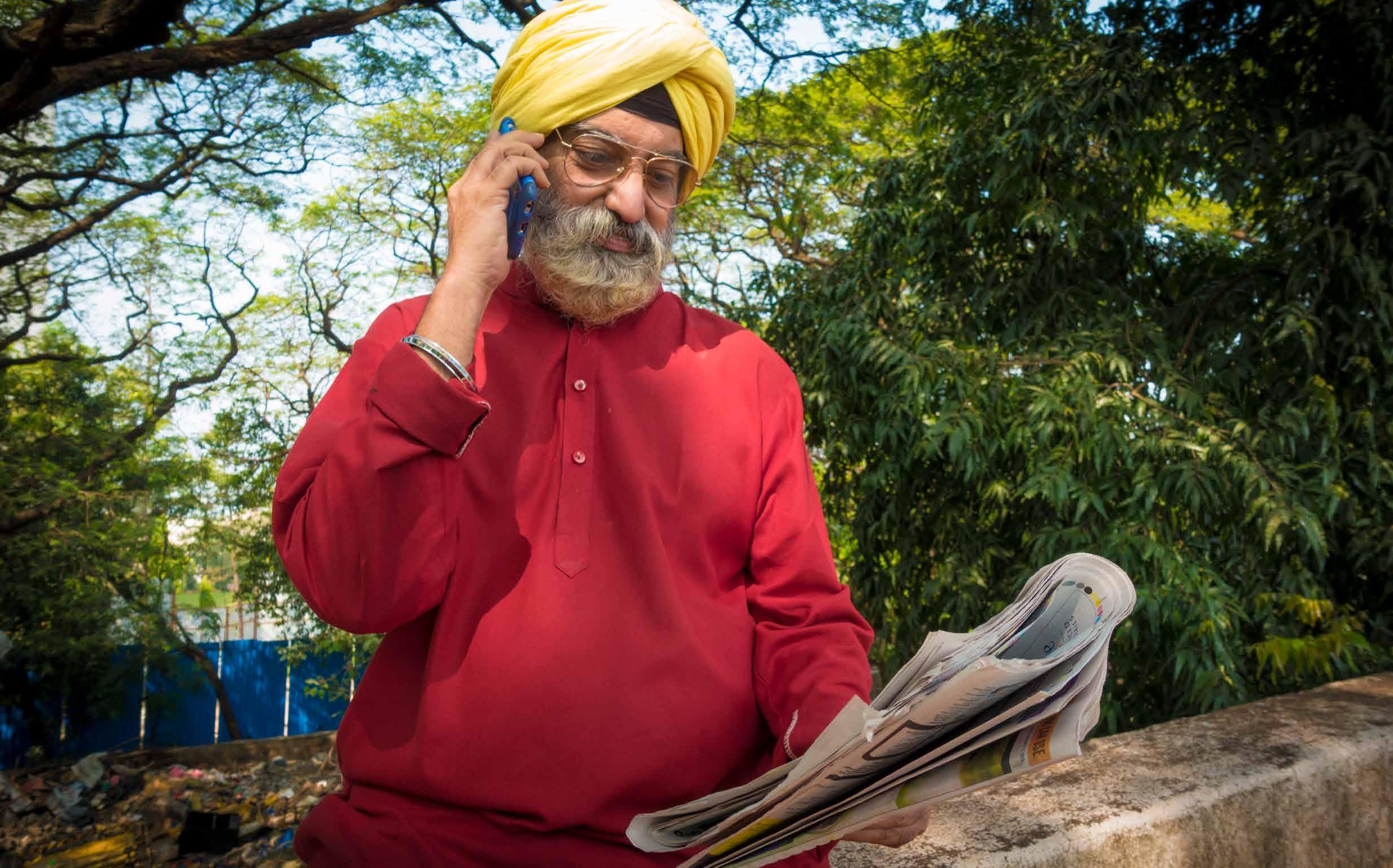
Our 10 insights provide a contextual basis for understanding the issues and opportunities facing digital financial service providers in India. However, success in this market will require a more granular understanding of specific consumer behaviors, desires, and challenges—which can vary substantially. Driving penetration of digital financial services clearly requires designing products that are tailored to meet the particular needs of each consumer segment within its technological boundaries.
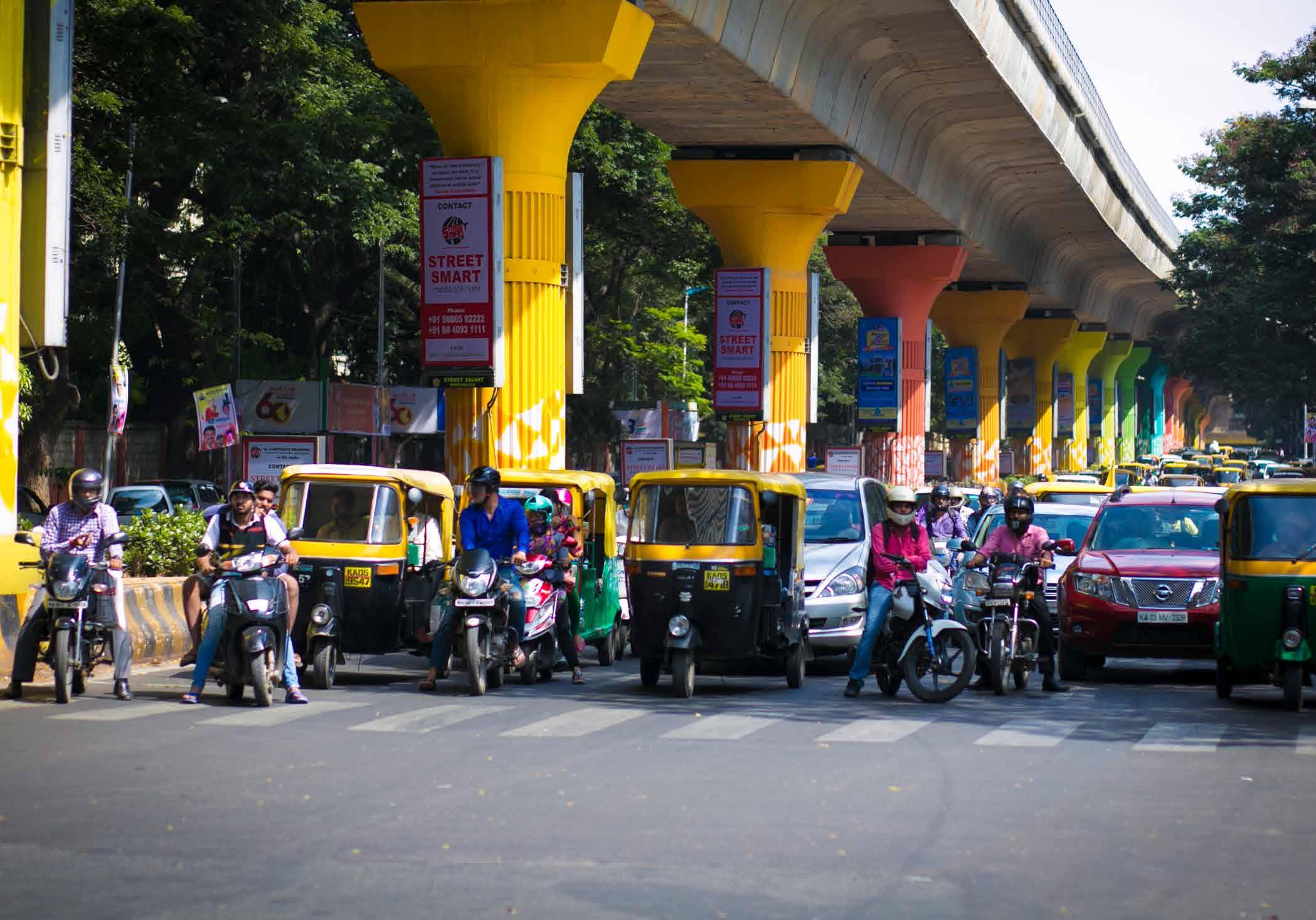
For that reason, we took a deep-dive into the data collected from our study participants to gain further insight into the hearts and minds of the Indian consumer. We noticed that an individual’s adoption of digital financial services is influenced mainly by individual personality traits, socioeconomic status, and access to technology. Socioeconomic status was defined by geographic location (from rural to urban), income level (low to middle), and the influence of socio-cultural norms and boundaries.
Two frameworks helped us synthesize and articulate our analysis:
1) Personality traits: Identifies four personal and community drivers and their degree of influence on the individual.
2) Persona profiles: Identifies five distinct consumer “types” that exhibit shared characteristics and personality trait maps.
While there are many possible individual personality traits that could potentially drive adoption of digital financial services, we identified four traits that appear to have the greater influence. We looked at how individuals think about their lives and future, how they value their families and communities, and how they conduct themselves in their daily routines at work and at home.
Ambition: Given their circumstances, how motivated is the person to improve his/her life and take chances to achieve goals?
Resourcefulness: How resourceful is the person within limited means?
Responsibility toward community: How much of a sense of obligation does the person feel toward his/her community?
Receptiveness to network: To what degree is the person’s behavior influenced by the people around them?
By creating personality trait maps for various groups of interviewees, we noticed five distinct persona types emerge. Each persona exhibits a set of shared attributes, including attitudes, behaviors, and needs, that are intertwined with their socioeconomic and demographic status. The five persona profiles are further segmented into 2-3 variants that provide more granular detail.
Each persona type requires a different pathway through which consumers may initiate or increase engagement with digital financial services. It’s also important to note that some segments may serve as a gateway to engaging a wider pool of potential adopters.
We have also estimated the potential addressable market associated with each identified persona. Given the challenge of sizing consumer segments based on personality characteristics, we have relied on simple demographic and behavioral characteristics to come to approximate sizes for these consumer segments.6 The rationale for each potential addressable market sizing is included within each persona profile. Due to the methodology used, these numbers should be considered directional and relative estimates rather than precise market segment sizings.
Aspirants are eager to move with the times and are influenced by the latest trends. They believe in the potential of technology, although they’re still in the process of discovering how it can improve their lives. Aspirants look forward to becoming financially independent and making their own decisions.
Young adults seeking financial independence
Desire to own a smartphone
Eager to adopt the latest trends
Believe in technology to help them improve their lives
Find creative ways to save money or borrow smartphones
Highly influenced by friends and relatives in aspirational areas
Equally at ease with forming their own ideas
Gain understanding of digital financial services
Try financial apps with confidence and trust
Handle digital payments responsibly
Become financially independent and make their own decisions
Save money to buy the latest smartphone
Sahil, engineering college student, Rajgir-Nalanda town, Bihar

“I use my friends’ mobile for WhatsApp and Facebook. I want to shop from Myntra when I get my smartphone.”
Trendsetter – borrows smartphones from friends and aspires to own whatever is newest and trendy
Restrained – secretly borrows smartphones despite being prohibited from using them
Striving – struggles to save enough for a smartphone, but intends to buy one as soon as possible
Potential addressable market7
Aspirants are a relatively large segment on the cusp of digital, as well as financial, adoption. They are generally men and urban or rurban8 women between the ages of 15 and 30 years who own a basic feature phone, but aim to upgrade to a smartphone soon. This demographic group represents an estimated 155 million people. We can also estimate this segment size by looking at current smartphone growth trends—among the 15-30 age group, about 115 million more people are expected to own a smartphone by 2020, many of whom are likely to be Aspirants.
Recommendations to financial services providers
Design apps with a simple user experience, well-defined focus, and clean, trendy design
Offer money-saving schemes and incentives
Provide positive communication around app security features
Enable offline mobile payments to overcome poor connectivity
Rural
Low income
Low restrictive environment
Basic phone Wi-Fi
SOCIOECONOMIC CONTEXT
RESTRAINED
Basic phone No internet
SOCIOECONOMIC CONTEXT
Urban
Middle income
High restrictive environment
Rural
Low income
Low restrictive environment
Basic phone No internet
SOCIOECONOMIC CONTEXT
Urban
Middle income
High restrictive environment
Rural
Low income
Low restrictive environment
Urban
Middle income
“The self help group gave me an identity and a community to rely on. You can get a loan with a 2 percent interest rate. But I’m not sure if I will get my third loan.”
Kallash Devi, farmer and laborer, Uthavalli village, Karnataka

Collaborators live in close, trusted, and supportive relationships with their communities. They rely on the community for guidance and are actively engaged in a range of community groups and schemes.
Share a strong drive to take care of their community
Rely on their community or trusted agents for guidance and advice
Participate in community-based savings and loans programs
Lack confidence with banks, believe that banks are not for them
Focus on day-to-day needs and saving for occasional basic expenditures
Resourceful with finding supplemental income
In constant need of credit, often borrowing from multiple sources
Communications in their local language
To be treated with respect by financial service staff
To break the cycle of taking multiple loans to make ends meet
Easier ways to keep track of terms and payments on various accounts
Follower – joins community-based lending groups, but has little understanding of the processes involved
Self-starter – juggles multiple jobs and loans to support the family and is resourceful in finding credit schemes
Potential addressable market7
Collaborators are a relatively large segment, generally comprised of people between the ages of 25 and 50 who live in rurban8 or rural areas. Men in this group own a basic phone or a “dark smartphone” (with no internet access), while women do not typically own a phone. This demographic group represents an estimated 250 million people. Collaborators favor traditional sources of credit, so we can also approximate the group size by estimating the number of men participating in chit funds and women participating in SHGs, which is roughly 185 million people.
Rural
Low income
Low restrictive environment
No
SOCIOECONOMIC CONTEXT
Urban
Middle income
High restrictive environment
SOCIOECONOMIC CONTEXT
Middle income
“I watch TV9 reality show with my husband and in-laws every evening. They show how excessive use of internet can lead to broken families.”
Deepa, homemaker, Bengaluru, Karnataka
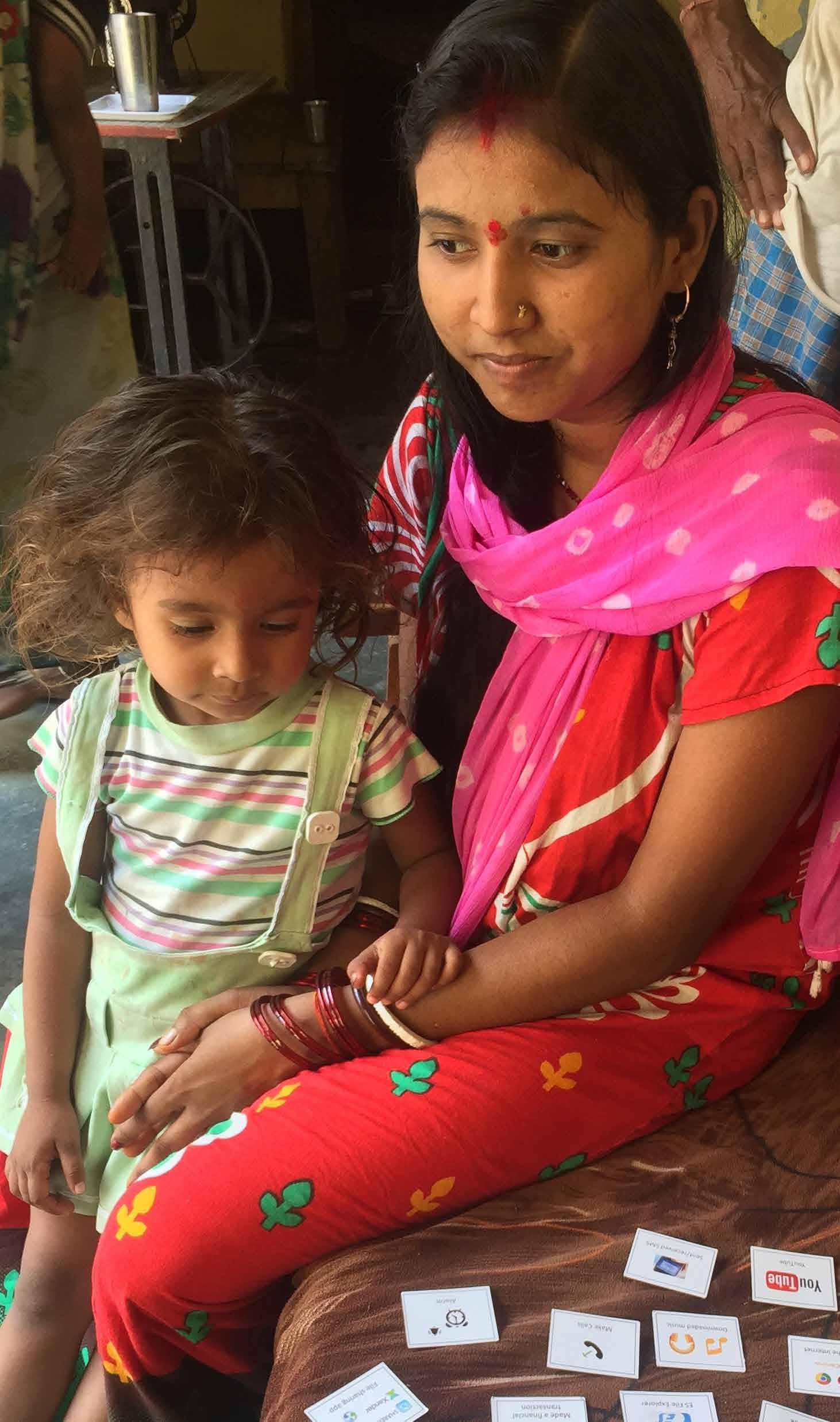
Conformists operate within strict boundaries that are defined by their family and community. They have access to technology, but hesitate to take full advantage of it—even if they see its value and potential.
Restrained by family and established socioeconomic norms
Highly controlled internet usage by male family members
Avoid conflict and happy to follow the rules
Happy to explore when restrictions are eased
Save money secretly for future family needs
Have access to technology, but are hesitant to take advantage of it
Focus on their family rather than advancing their own lives or careers
Independent access to the internet and mobile phone
Easier ways to track their “hidden” savings and manage household expenses
Useful online resources to help their children’s education and family well-being
Trier – is curious about e-commerce apps but also wary of online identity theft
Homemaker – uses a smartphone but is closely monitored by her husband
A relatively small segment, Conformists are generally women between the ages of 20-50 in rurban8 or urban areas who own a smartphone. Excluding high-income women, this demographic group represents an estimated 25 million people. We can also approximate this group size by estimating the number of women who seem to refrain from using social network services like Facebook (as compared to usage by men), which is an estimated 20 million people.
Rural
Low income
Low restrictive environment
Urban
Middle income
High restrictive environment
Rural
Low income
Low restrictive environment
Urban
Middle income
High restrictive environment
Design apps with image-based UIs to keep track of savings hidden around the house
Reposition the prime purpose of mobile internet usage away from social media and toward family-focused use cases
Include family during onboarding to help build trust
Enable anonymous logins to support trial transactions and build confidence
Provide free or heavily discounted data plans to help control costs
Include a help or complaint button for immediate redressal
Smartphone Wi-Fi & 3G Data“I set up a mobile data hot spot using a spare phone in my store, so my customers can access free 2G internet. This boosted my business.”
Ramesh, mobile and Xerox store owner, Utharthu village, Bihar

Masters are the “go-to experts” for their community, providing updates and information on all things new and innovative. They thrive on the social standing that results from their initiative and intelligence, and continuously seek ways to build relationships.
Go-to experts in their community, helping to introduce new things
Outgoing, social, thrive on community status and being seen as a pioneer
Ambitious, resourceful, often juggling multiple jobs to earn extra income
Regularly experiment with new products, services, and technologies
Some are entrepreneurial, starting new businesses or initiatives
Appreciate technology that helps them connect and share
Experts at finding deals, such as free internet access
Easier tracking of multiple sources of income
Cheap and reliable ways to access the internet Gain expertise in digital financial services
Networker – uses the internet heavily for entertainment, social networking, but is uncomfortable with online transactions
Entrepreneur – runs a business that sells mobile phones and other technology-related services
Activator – sets up SHGs and encourages women to do the same
Potential addressable market7
The Masters are a relatively small group; however, they are highly influential within their network. Female Masters tend to be between 25 and 50 years of age, live in rurban8 or rural areas, and own a basic feature phone, while male Masters tend to be between 15 and 35 years, live in urban areas, and own a smartphone. In both cases, Masters set themselves apart from their demographic segment by being recognized as experts that have especial influence in their networks. Given these characteristics, and excluding high-income individuals, we estimate roughly 12.5 million people in India are Masters. We could also approximate this segment size by looking at young men, who are the most sophisticated users of smartphones and data, and females who lead SHGs. These groups represent an estimated 25 million people.
Leverage agent network to raise awareness of USSD apps and amplify outreach
Design dedicated apps that offer a single, well-defined focus and build trust around transaction security
Offer ongoing deals and incentives to drive sustained usage
Provide various forms of help, including online and offline, to build confidence
Pragmatists take initiative, whether in starting a business, advancing their careers, or taking care of their families. They are fundamentally practical, prioritizing ease, convenience, efficiency, and cost.
Proactive and entrepreneurial in many areas of their lives
Clear personal and professional goals, continuously looking for ways to grow
Prioritize ease, convenience, efficiency, and cost in decision-making
Carefully weigh any advice against their own priorities
Willing to experiment, but reluctant to commit when they experience challenges
Look for cost savings and incentives
Actively interested in digital financial services, but want more than simply mobile top-up and bill payments
Mobile apps that can operate in low connectivity areas
Gain trust in order to try higher-value digital transactions
Convenient and cost-effective solutions
Aditya, Hot Chips store owner, Bengaluru, Karnataka

Enthusiast – invests in in-store digital payment systems with the expectation of growing usage in future
Reserved – avoids complex apps and prefers to use his mobile phone for simple use cases
Pragmatists are a mid-sized segment group that has the potential to be high-value users. They are generally men between the ages of 25 and 50 who use a smartphone with data services. Excluding high-income men, this demographic group represents an estimated 60 million people. The most common place to find Pragmatists would be among infrequent user base of mobile banking apps and digital wallets, as well as e-commerce apps, such as IRCTC and Flipkart.
Rural
Low income
Low restrictive environment
Smartphone
SOCIOECONOMIC CONTEXT
Urban
Middle income
High restrictive environment
Rural
Low income
Low restrictive environment
SOCIOECONOMIC CONTEXT
Urban
Middle income
Recommendations to financial services providers
Design apps with a simple, intuitive UI and single, well-defined focus
Provide agent assistance with onboarding and guided demonstration of use cases
Emphasize convenience and data security of financial services apps
Waive convenience fees for online transactions and SMS receipts
Provide instant and clear digital receipts, especially for failed transactions

During the process of analyzing field data and defining the five personas, we identified commonalities within each that formed the basis of our recommendations to digital financial services providers and stakeholders. We then mapped those recommendations across the technology consumer journey, which includes four stages: awareness of use cases and potential, onboarding and trial, early use, and long-term use. We looked at an additional layer of help and redressal that impacts usage.
The five persona profiles in the previous section include a summary of our top insights and recommendations tailored to each group.
For a higher-level view, we’ve distilled the following general recommendations that universally apply across personas.

Create awareness of specific use cases that reframe the benefits of mobile.
Many people are dubious about the suitability of using smartphones and mobile internet, especially by women. For women across personas, it is important for digital financial services providers to reposition the prime purpose of mobile internet toward socially acceptable use cases, such as education and health, and away from those considered inappropriate, such as entertainment and social media.

Offer guided onboarding and handholding for the first transaction.

Across personas, people want agents to demonstrate how to use digital financial services and walk them through all possible use cases, including app installation. Some are excited about the possibility of carrying out dummy transactions with their agent or a vendor before transacting with money. A focused and highly supportive onboarding experience helps build familiarity and confidence with using an app from first use.
Present a clean user experience, free of financial services jargon.
Many consumers express a strong desire to have all communication from financial service providers, including calls, texts, handouts, and in-person conversations, be free of financial services jargon as it makes them feel “uneducated.” With apps, they want a clean and focused user interface so that they can easily find what is required and successfully accomplish their intended actions.
Make new customers comfortable by providing trustbuilding services, coupled with incentives to motivate use where appropriate.
For many consumers, one of their biggest fears with using digital financial services is unintended consequences due to a failed transaction. To overcome this fear, consumers who have used such services often start with small ticket transactions. They progress to transacting with larger amounts once they are familiar with the application and have gained confidence in their ability to understand and navigate the experience. Apps further support this journey by building in features that enhance consumer trust, such as allowing users to save information while they move between applications.

Offer consistent and easy access to immediate help.
For many, a complaint or help button is essential to overcoming the education barrier. When faced with a problem, users don’t know who to turn to and believe that a redressal button for immediate troubleshooting would be beneficial. Some also want “smart help,” which can detect where they are stuck, point out any mistakes, and guide them toward successfully completing their action.
Provide incentives after initiation.
Across all personas, people are excited about digital finance because of cashbacks and incentives. They express interest in free or discounted data plans by Jio, Idea, and others, and want the cashbacks and incentives to continue post-initiation. Industry experts also spoke about potentially incentivizing digital credit by gamifying credit scores. For example, people with high credit scores would get preferential treatment with PayTM, banking websites, railway tickets (IRCTC), and others.

One of the key focus areas of our study was the influence of the digital ecosystem on the opportunities and challenges for digital financial services in India. Government, financial services and technology providers, MNOs, and device manufacturers each play a unique role in enabling India’s diverse consumer base to bridge the digital divide between traditional approaches to finance and the new world of mobile-powered services.

Furthermore, it is essential that all stakeholders come together in order to increase engagement with digital financial services and realize its potential to improve lives. Without government regulation, safety will be a key concern. Without devices becoming affordable, such services cannot be universally accessible. Without MNO intervention, connectivity issues will deter adoption. And without the involvement of digital financial service providers, innovative solutions will not come to market. The consumer experience will not be seamless without these partnerships.
Building on our general and persona-specific recommendations in the previous section, we propose three strategies for each of the main stakeholders in the ecosystem that can help drive awareness, access, adoption, and usage of digital financial services nationwide.
Strengthen shared infrastructure. Ensure universal connectivity by 2018 and ensure universal acceptance of digital payments in government networks.
Promote common standards and centralized mechanisms around security and trust. Set up grievance redress mechanisms, mandate free digital transaction receipts, define design guidelines to simplify text-based USSD interfaces.
Launch focused initiatives to close the gender gap. Incentivize or mandate Direct Benefit Transfers (DBT) into women-owned accounts, launch DBT-linked products, fully digitize SHG payments, and deepen the community-led bank correspondents network through the governmentsupported “Bank Mitra” program.
Improve product design and regulation. Address the disconnect between how consumers think of products (fluid mental models) and how products are designed (silos with rigid boundaries). Consider regulations around unified distribution, e.g., bundles. Base regulations on underlying function and not on provider type.
Improve consumer protection. Design communications that use colloquial language and minimal jargon. Provide on-demand help through chat-bots or other technology. Provide supervision and redressal mechanisms around agent transactions.
Incorporate voice of customer into policymaking. Set up independent feedback processes. Commission regular consumer behavior research to assess the needs of underserved consumer segments.
Simplify, streamline, and secure the user experience. Invest in UI/ UX that is simple, data light, graphical, and uses the local colloquial language. Simplify current Unified Payments Interface (UPI) apps, and explore loyalty and incentive models to drive onboarding and trial.
Drive product and service innovation. Deliver products that are tailored to each persona’s requirements. Create an online SHG payment or a household expense tracking app for women, expand USSD products, create products that leverage digital data trails, and explore partnerships with MNOs and other financial services and technology providers.
Strengthen and extend agent networks. Employ community-based bank correspondents and train them to help with consumer onboarding, first use, and grievance redressal. Design integrated feedback loops and communication strategies that combine agents and digital channels.
Advancements in technology, investments in digital infrastructure, and a strong regulatory push have enabled an unprecedented level of low-cost access to basic formal financial services. However, sustained usage of such services has been limited and many consumer segments remain underserved. Deeply rooted behavior change will require an in-depth understanding of the behaviors, attitudes, and needs that are likely to drive digital financial services in India.
The building blocks for universal access to financial services are falling into place in India. Financial inclusion is very much on the agenda of government agencies and regulators, and the digital financial services ecosystem is already investing heavily in developing the sector. The next step for stakeholders is to listen and respond to the voice of the consumer by delivering on the promise of such services across broader customer segments.

We believe the consumer personas framework highlighted in this piece can offer a valuable key to unlock customer acquisition and help scale digital financial offerings. The first step is to identify the Masters within each target-community and turn them into champions of digital financial offerings. With their help, providers can reach other groups, such as Pragmatists and Collaborators. Women-Masters can also facilitate engagement with Conformists. By providing incentives and free trials, providers can also bring Aspirants to the fold—who can very well become the Masters of tomorrow.
This report presents a clear call to action to better tailor initiatives to meet specific consumer needs, and help people use digital financial services to achieve positive financial outcomes that lead to income growth, financial resilience, and an improved standard of living.
The Currency of Trust study was conducted by Dalberg Global Development Advisors and used a mixed method research approach to analyze the context and behaviors of a diverse sample of Indian consumers in order to better understand their readiness for digital financial services. Our methodology was focused on answering the following key questions:
What do people’s digital and financial lives look like today?
Why do some believe that formal financial services and digital financial technologies are not for them?
What is the impact of technology affordability and connectivity on digital usage?

Which use cases resonate the most?
What UI/UX design principles are important for consumers?
What are the opportunities for intervention throughout the consumer journey to transition people to using digital financial services?
To inform our market analysis, we used existing data sets from several stakeholders and over 50 industry reports. We conducted over 20 interviews with industry experts, including senior industry leaders, regulators, and entrepreneurs.
We used a human-centered design (HCD) approach to form a detailed understanding of consumer needs, behaviors, and fundamental motivations. We conducted 250 in-depth qualitative interviews with 384 consumers across 30 communities in Nagaland, Bihar, Maharashtra, Karnataka, and Telangana, covering a mix of rural, semi-urban, and urban areas. We spent one to two hours with each respondent, including their household and family, and explored the experiences, relationships, and attitudes that drive their financial decisions, as well as their use of digital services. They walked us through their typical day, chronicling their daily financial flows and management processes. We listened to their hopes and dreams for the future, understood their circle of trust, and co-created potential solutions with them.





As part of our qualitative process, we conducted sessions with users to better understand their experience and preferences with respect to financial services applications. Participants were excited to explore prototypes of several novel use cases for digital financial services beyond the familiar ones (online remittance, utility bill payment, e-commerce, direct benefit transfers). Co-creation sessions captured ideas and requirements for user interface design elements, features, and overall user experience flows, specifically those related to language.
The final step of our process was to synthesize the data gathered during the study and generate insights, develop a behavioral persona model, identify opportunities, and make recommendations. We presented our findings in a stakeholder workshop that included 21 participants from 19 companies, which resulted in 20 new ideas for potential digital solutions.
We would like to thank Dalberg Global Development Advisors and Dalberg Design Impact Group (DIG) for their work on this report, particularly Ravi Chhatpar, Varad Pande, and Keshinee Shah for their leadership; Prerak Mehta for literally crossing the country in order to capture hundreds of consumer perspectives with a human-centered design lens; and the rest of the team, including Vineet Bhandari, Anant Lalla, Pragya Mishra, and Kanupriya Rungta, for their excellent research and analysis.
[1] Numbers from The Indian Telecom Services Performance Indicator Report, TRAI, September 2016; and Forecast of mobile phone users in India, Statista
[2] Numbers based on Dalberg analysis of the following: FII, 2016; and Wave Report FII Tracker Survey.
[3] Numbers based on Dalberg analysis of FII Wave 3.
[4] Based on Dalberg research and analysis of the following: MA Intelligence, 2015; The Mobile Economy, India 2015; Forecast of smartphone users in India, Stadista; Cisco, 2016; VNI Mobile Forecast 2015-2020; India Internet Report, Goldman Sachs; and FII Wave 3.
[5] For the purpose of this comparison, banking agents are considered equivalent to bank correspondents in India and non-banking agents are considered agents of financial institutions without a full banking license, such as micro-finance institutions, gold loan companies, mobile money operators, etc. Agent numbers for Brazil, Kenya, Pakistan, and Tanzania sourced from Supervision of Banks and Nonbanks Operating Through Agents, CGAP; Bank agent data for India sourced from RBI Annual Report, 2016. Nonbanking agents for India are assumed to be the same as banking agents.
[6] In many cases, the boundaries of persona segment groups overlap, due to similar demographic and behavioral characteristics. We assume that the true persona segments also include people outside of the calculated group, and therefore the segments would not overlap in practice.
[7] Potential addressable market is an estimate by Dalberg analysis of the number of people who might exhibit demographic and behavioral characteristics similar to the personas identified by the consumer research. These estimates should not be considered as an exact representation of persona groups size.
[8] “Rurban” is an Indian census term that indicates towns with less than 100,000 people.
